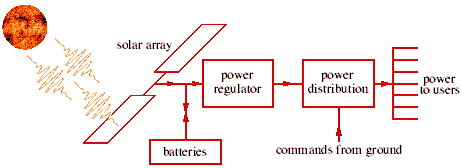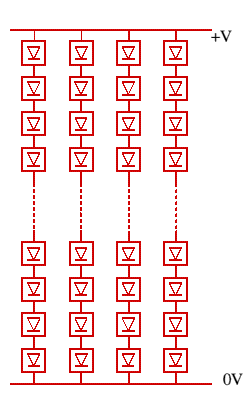


ELECTRICAL POWER AND SIMPLE DC CIRCUITS
A good and important example of the application of DC electrical theory to XMM is the power supply system. The importance is obvious since the entire spacecraft operation is dependent on a continuous, high quality supply of electrical power.
The principal components of the power system are:
- a solar array
- storage batteries
- a power regulator system
- a power distribution system.
The original source of the energy which enables XMM to operate is the energy of sunlight. This is converted into electrical power by the solar array below. However, sunlight is not always available - for example, when the satellite is in the shadow of the Earth, which occurs for a short period on each orbit. So sufficient energy must be stored in batteries when the satellite is on the sunlit side of the Earth to keep it operating when it moves into the shadow. For various reasons ranging from the partial discharge of the batteries to ageing of the solar array in the Earth's radiation belts, the resulting supply is not very stable, and so a power regulator is used to improve its quality. Finally the power must be distributed to all the many "users" on the spacecraft; this has to be done in a way which enables these users to be switched on and off when required from the ground using the spacecraft command system. This is how these systems are connected together:

The solar array

The solar array is divided into two sections, one on each side of the spacecraft with a total area of 21 m2. Each section is made up of a large number of individual cells, each 40 by 20 mm, made of silicon semi-conductor material. A detailed description can be found in the section "How do solar cells work?". Solar cells are photo-diodes and sunlight absorbed in the semi-conductor releases electrical charge in the form of a photo-current. Each cell has an operating voltage of about 530 mV and when first launched will convert sunlight to electrical energy with an efficiency of about 15%, the rest of the energy simply heating the array. However, the cells degrade with use, particularly in the Earth's radiation belts , and after a lifetime of 10 years the efficiency will have dropped to perhaps 12%. About 60 cells are connected in series in a string to produce an output voltage of 28 V, and then strings are connected in parallel to generate the required output current. In practice, electrical diodes are also included in each string so that if one becomes short-circuited, it does not short out the others.
The maximum amount of power will be generated when the array is perpendicular to the direction of the Sun. The viewing direction of the main telescopes is restricted to ensure that the angle between the array and the Sun never exceeds 28 degrees. The average power produced is also reduced by the time (up to 1.7 hours in some of the 48 hour orbits) spent in the Earth's shadow.
Problem 1:
From the figures given above and the fact that the energy carried by sunlight when measured above the atmosphere is 1370 Wm-2, calculate the maximum possible power produced by the XMM solar array, and also the mean power over an orbit under the most unfavourable conditions at the end of XMM's life. To check your answer, click here
The battery sub-system
The batteries used for power storage in satellites are similar in principle to the lead-acid batteries used for this purpose in cars. However, the satellite's batteries must be hermetically sealed to operate in near-vacuum, they must be light-weight and they must deliver high efficiency and reliability over a wide range of operating temperature. Finally, they also need a long operational life. For these reasons, XMM uses nickel-cadmium (Ni-Cd) batteries, which are charged up in the sunlit part of the orbit and then discharge either at times of peak power demand, or during the shadow portion of the orbit when the solar array is inactive. The efficiency of Ni-Cd batteries is about 75%, that is, this fraction of the charging energy can be recovered during discharge, the remainder being used up in other ways such as heating of the battery whilst a current is flowing during discharge.
Problem 2:
In normal operation, XMM consumes 1400 W of electrical power. Assuming that the batteries are charged at the same rate over the whole of the sunlit portion of the orbit and that this amount of power is used in eclipse, calculate the mean power which must be supplied to them by the solar array. Then check that the XMM array at the end of life will have the capacity necessary to operate the entire spacecraft, including the battery charger. (This calculation is actually somewhat unrealistic, because in reality the battery charger does not spread the battery charge over such a long period, but carries out the charging in the way which will give the best combinationation of battery efficiency and battery life. In addition, the telescopes are not on during eclipse which reduces the power required.) To check your answer, click here
The power regulator
The power regulator is really a complex system with a good deal of built-in "intelligence". With minimum control from the ground, it has to run the whole power system at the greatest possible efficiency including controlling the battery charging. It must also be highly reliable because without it the whole spacecraft would be lost. It is designed to operate on its own even if a fault develops in orbit for at least 36 hours.
Problem 3:
One of the normal functions of the power regulator is to take the power provided by the solar array or the batteries (in eclipse) which is at a varying input voltage from 25 to 40 V, and convert this to a supply at 28 V which is then distributed around the spacecraft. If the regulator has a power efficiency of 90%, calculate the input current when the input voltage is 25 V and also when it is 40 V. To check your answer, click here
The power distribution system
The power distribution system provides power to all the different parts of the spacecraft, such as the different instruments in the telescopes, but also to parts of the spacecraft such as the telemetry transmitters. It has built-in modes of operation which turn these components on so as to build up the normal operating mode of the spacecraft in sunlight or eclipse. In addition, rather like the 240 V power supply in your home, it can detect when one of its users is taking too much current, perhaps because a fault has developed. and turn it off. To allow for changes in the operating configuration over the spacecraft's lifetime, the distribution system's modes can be re-programmed from the ground using the command system.
The End of the ELECTRICAL POWER AND SIMPLE DC CIRCUITS topic.

